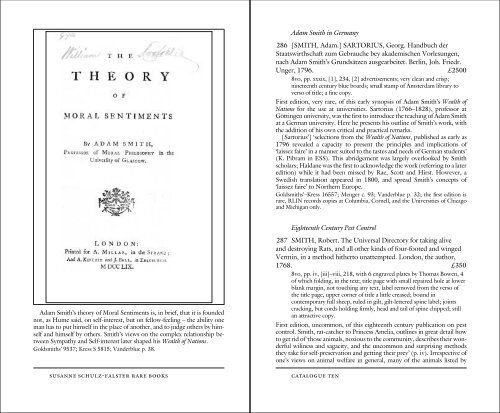Susanne Schulz-Falster Catalogue Ten - Schulz-Falster Rare Books
Susanne Schulz-Falster Catalogue Ten - Schulz-Falster Rare Books
Susanne Schulz-Falster Catalogue Ten - Schulz-Falster Rare Books
You also want an ePaper? Increase the reach of your titles
YUMPU automatically turns print PDFs into web optimized ePapers that Google loves.
Adam Smith’s theory of Moral Sentiments is, in brief, that it is founded<br />
not, as Hume said, on self-interest, but on fellow-feeling – the ability one<br />
man has to put himself in the place of another, and to judge others by himself<br />
and himself by others. Smith’s views on the complex relationship between<br />
Sympathy and Self-interest later shaped his Wealth of Nations.<br />
Goldsmiths’ 9537; Kress S 5815; Vanderblue p. 38.<br />
Adam Smith in Germany<br />
susanne schulz-falster rare books catalogue ten<br />
286 [SMITH, Adam.] SARTORIUS, Georg. Handbuch der<br />
Staatswirthschaft zum Gebrauche bey akademischen Vorlesungen,<br />
nach Adam Smith’s Grundsätzen ausgearbeitet. Berlin, Joh. Friedr.<br />
Unger, 1796. £2500<br />
8vo, pp. xxxix, [1], 234, [2] advertisements; very clean and crisp;<br />
nineteenth century blue boards; small stamp of Amsterdam library to<br />
verso of title; a Wne copy.<br />
First edition, very rare, of this early synopsis of Adam Smith’s Wealth of<br />
Nations for the use at universities. Sartorius (1766–1828), professor at<br />
Göttingen university, was the Wrst to introduce the teaching of Adam Smith<br />
at a German university. Here he presents his outline of Smith’s work, with<br />
the addition of his own critical and practical remarks.<br />
[Sartorius’] ‘selections from the Wealth of Nations, published as early as<br />
1796 revealed a capacity to present the principles and implications of<br />
‘laissez faire’ in a manner suited to the tastes and needs of German students’<br />
(K. Pibram in ESS). This abridgement was largely overlooked by Smith<br />
scholars; Haldane was the Wrst to acknowledge the work (referring to a later<br />
edition) while it had been missed by Rae, Scott and Hirst. However, a<br />
Swedish translation appeared in 1800, and spread Smith’s concepts of<br />
‘laissez faire’ to Northern Europe.<br />
Goldsmiths’–Kress 16557; Menger c. 93; Vanderblue p. 32; the Wrst edition is<br />
rare, RLIN records copies at Columbia, Cornell, and the Universities of Chicago<br />
and Michigan only.<br />
Eighteenth Century Pest Control<br />
287 SMITH, Robert. The Universal Directory for taking alive<br />
and destroying Rats, and all other kinds of four-footed and winged<br />
Vermin, in a method hitherto unattempted. London, the author,<br />
1768. £350<br />
8vo, pp. iv, [iii]–viii, 218, with 6 engraved plates by Thomas Bowen, 4<br />
of which folding, in the text; title page with small repaired hole at lower<br />
blank margin, not touching any text, label removed from the verso of<br />
the title page, upper corner of title a little creased; bound in<br />
contemporary full sheep, ruled in gilt, gilt-lettered spine label; joints<br />
cracking, but cords holding Wrmly, head and tail of spine chipped; still<br />
an attractive copy.<br />
First edition, uncommon, of this eighteenth century publication on pest<br />
control. Smith, rat-catcher to Princess Amelia, outlines in great detail how<br />
to get rid of ‘those animals, noxious to the community, describes their wonderful<br />
wiliness and sagacity, and the uncommon and surprising methods<br />
they take for self-preservation and getting their prey’ (p. iv). Irrespective of<br />
one’s views on animal welfare in general, many of the animals listed by
















